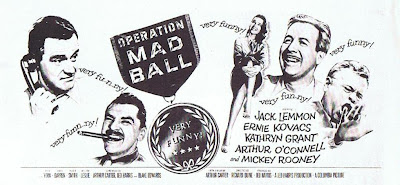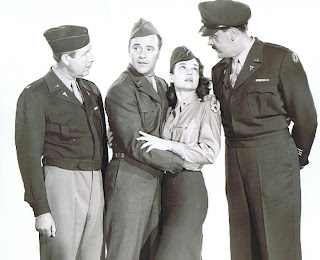 Jack Lemmon turned in one of his finest, most assured and confident and also most unheralded performances in 1957's ”Operation Mad Ball,” Richard Quine's long-lost military farce that will be receiving a rare showing on Turner Classics at 8 a.m. (est) on Saturday, July 19th.
Jack Lemmon turned in one of his finest, most assured and confident and also most unheralded performances in 1957's ”Operation Mad Ball,” Richard Quine's long-lost military farce that will be receiving a rare showing on Turner Classics at 8 a.m. (est) on Saturday, July 19th.To date, Sony has yet to release this minor gem on any home entertainment format, although it was reported recently on "reports from the lost continent of cinephilia," Dave Kehr's lively blog, that both it and "The Notorious Landlady" (1962), also directed by Quine, would be part of an upcoming boxed set devoted to Lemmon.
"Mad Ball," written by Jed Harris, Blake Edwards and Arthur Carter (adapted from Carter's play), is something of a '50s Playboy cartoon that can't be maintained as a single-frame strip and comes hilariously to life - what with the usual barracks of horny guys quietly lusting after female officers who are enticingly buttoned up in their regulation uniforms.
Lemmon plays Pvt. Hogan, the incorrigible schemer who hatches a plan to bring the men and (willing) women together at an illegal military bash to end all illegal military bashes. It's an ensemble piece with perfectly cast ensemble performers but, still, Lemmon manages to take center stage and command it but without ever really hogging it.
His Pvt. Hogan plays like a natural extention of his Ensign Pulver in "Mister Roberts" (1955), coated with a nice knowing swagger and a little more maturity. Actually, Hogan plays like a combination of Pulver and Roberts and I've a hunch that Lemmon planned it just that way.
His smooth delivery of the unexpectedly literate dialogue and witty banter (you can see Edwards's fingerprints on most of the quips) may be better than his line readings in even "The Apartment." This is Lemmon during his naturalist period, with no finicky bits of business to get in the way.
And his remarkable rapport and generosity with the cast around him only hightlights his - and the film's - naturalism.
Look for memorable bits by then-newcomers Dick York, William Hickey, William Leslie, James Darren, Roger Moore, Paul Picerni, L. Q. Jones, David McMahon, Sheridan Comerate and Dick Crockett (director Quine's right-hand man off screen and frequent co-star in his films) as the various guys in awe of Hogan's assorted shameless cons.

Ernie Kovacs, in a terrific film debut (and the first of three films that he made with Quine and Lemmon), makes a fastideous villain as Hogan's rigid nemesis; the always-reliable Arthur O'Connell is the camp's endearingly befuddled commander; Kathryn Grant (Crosby) supplies the sweet love interest, and Jeanne Manet, a wonderful, little-know French actress who disappeared from the screen far too soon, is outstanding as Madame LaFour, the cynical French woman who provides Hogan with a location for his mad ball - for a price.

And then there's Mickey Rooney, running, jumping and dancing all over the place as a hipster soldier (and York's cousin) who talks like a '50s beat poet way ahead of his time. The film is set in 1945.
In many ways, "Operation Mad Ball" is the '50s precursor to Robert Altman's "M*A*S*H" (1970), boasting the same amount of irreverent, dark humor. The only difference is that it uses Coke in lieu of blood for one of the film's funny visual gags. (You have to see the film to get it.)
I mean, here is a military comedy that, not unlike "M*A*S*H," locates humor in the word "coagulate."
Note in Passing: The title song performed over the film's opening credits was composed by Fred Karger with lyrics by director Quine. It is sung by an uncredited Sammy Davis, Jr.
(Artwork: A newspaper display ad for Quine's "Operation Mad Ball" and the usual studio publicity shots - standard for that era - of stars Lemmon, Kovacs, Grant and O'Connell)
No comments:
Post a Comment